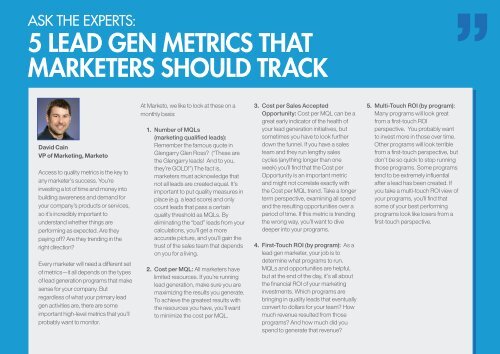The Definitive Guide to Lead Generation
TABLE OF CONTENTS Part One: Introduction to Lead Generation Chapter One: What is Lead Generation and Why is it Important? Chapter Two: How Has Lead Generation Evolved? Chapter Three: Defining a Lead Part Two: Lead Generation Tactics Chapter Four: Content Marketing and Blogging Chapter Five: Website and SEO Chapter Six: Landing Pages Chapter Seven: Social Media and Lead Generation Chapter Eight: Email Marketing Chapter Nine: Paid Programs Chapter Ten: Telephone-Based Lead Generation Chapter Eleven: Middle-of-Funnel Lead Generation Part Three: Optimize and Measure Your Lead Generation Chapter Twelve: Testing and Optimization Chapter Thirteen: Metrics Chapter Fourteen: Lead Generation Technology Conclusion: Lead the Way! Appendix: References
TABLE OF CONTENTS
Part One: Introduction to Lead Generation
Chapter One: What is Lead Generation and Why is it Important?
Chapter Two: How Has Lead Generation Evolved?
Chapter Three: Defining a Lead
Part Two: Lead Generation Tactics
Chapter Four: Content Marketing and Blogging
Chapter Five: Website and SEO
Chapter Six: Landing Pages
Chapter Seven: Social Media and Lead Generation
Chapter Eight: Email Marketing
Chapter Nine: Paid Programs
Chapter Ten: Telephone-Based Lead Generation
Chapter Eleven: Middle-of-Funnel Lead Generation
Part Three: Optimize and Measure Your Lead Generation
Chapter Twelve: Testing and Optimization
Chapter Thirteen: Metrics
Chapter Fourteen: Lead Generation Technology
Conclusion: Lead the Way!
Appendix: References
You also want an ePaper? Increase the reach of your titles
YUMPU automatically turns print PDFs into web optimized ePapers that Google loves.
ASK THE EXPERTS:<br />
5 LEAD GEN METRICS THAT<br />
MARKETERS SHOULD TRACK<br />
David Cain<br />
VP of Marketing, Marke<strong>to</strong><br />
Access <strong>to</strong> quality metrics is the key <strong>to</strong><br />
any marketer’s success. You’re<br />
investing a lot of time and money in<strong>to</strong><br />
building awareness and demand for<br />
your company’s products or services,<br />
so it’s incredibly important <strong>to</strong><br />
understand whether things are<br />
performing as expected. Are they<br />
paying off? Are they trending in the<br />
right direction?<br />
Every marketer will need a different set<br />
of metrics—it all depends on the types<br />
of lead generation programs that make<br />
sense for your company. But<br />
regardless of what your primary lead<br />
gen activities are, there are some<br />
important high-level metrics that you’ll<br />
probably want <strong>to</strong> moni<strong>to</strong>r.<br />
At Marke<strong>to</strong>, we like <strong>to</strong> look at these on a<br />
monthly basis:<br />
1. Number of MQLs<br />
(marketing qualified leads):<br />
Remember the famous quote in<br />
Glengarry Glen Ross? (“<strong>The</strong>se are<br />
the Glengarry leads! And <strong>to</strong> you,<br />
they’re GOLD!”) <strong>The</strong> fact is,<br />
marketers must acknowledge that<br />
not all leads are created equal. It’s<br />
important <strong>to</strong> put quality measures in<br />
place (e.g. a lead score) and only<br />
count leads that pass a certain<br />
quality threshold as MQLs. By<br />
eliminating the “bad” leads from your<br />
calculations, you’ll get a more<br />
accurate picture, and you’ll gain the<br />
trust of the sales team that depends<br />
on you for a living.<br />
2. Cost per MQL: All marketers have<br />
limited resources. If you’re running<br />
lead generation, make sure you are<br />
maximizing the results you generate.<br />
To achieve the greatest results with<br />
the resources you have, you’ll want<br />
<strong>to</strong> minimize the cost per MQL.<br />
3. Cost per Sales Accepted<br />
Opportunity: Cost per MQL can be a<br />
great early indica<strong>to</strong>r of the health of<br />
your lead generation initiatives, but<br />
sometimes you have <strong>to</strong> look further<br />
down the funnel. If you have a sales<br />
team and they run lengthy sales<br />
cycles (anything longer than one<br />
week) you’ll find that the Cost per<br />
Opportunity is an important metric<br />
and might not correlate exactly with<br />
the Cost per MQL trend. Take a longer<br />
term perspective, examining all spend<br />
and the resulting opportunities over a<br />
period of time. If this metric is trending<br />
the wrong way, you’ll want <strong>to</strong> dive<br />
deeper in<strong>to</strong> your programs.<br />
4. First-Touch ROI (by program): As a<br />
lead gen marketer, your job is <strong>to</strong><br />
determine what programs <strong>to</strong> run.<br />
MQLs and opportunities are helpful,<br />
but at the end of the day, it’s all about<br />
the financial ROI of your marketing<br />
investments. Which programs are<br />
bringing in quality leads that eventually<br />
convert <strong>to</strong> dollars for your team? How<br />
much revenue resulted from those<br />
programs? And how much did you<br />
spend <strong>to</strong> generate that revenue?<br />
5. Multi-Touch ROI (by program):<br />
Many programs will look great<br />
from a first-<strong>to</strong>uch ROI<br />
perspective. You probably want<br />
<strong>to</strong> invest more in those over time.<br />
Other programs will look terrible<br />
from a first-<strong>to</strong>uch perspective, but<br />
don’t be so quick <strong>to</strong> s<strong>to</strong>p running<br />
those programs. Some programs<br />
tend <strong>to</strong> be extremely influential<br />
after a lead has been created. If<br />
you take a multi-<strong>to</strong>uch ROI view of<br />
your programs, you’ll find that<br />
some of your best performing<br />
programs look like losers from a<br />
first-<strong>to</strong>uch perspective.

















